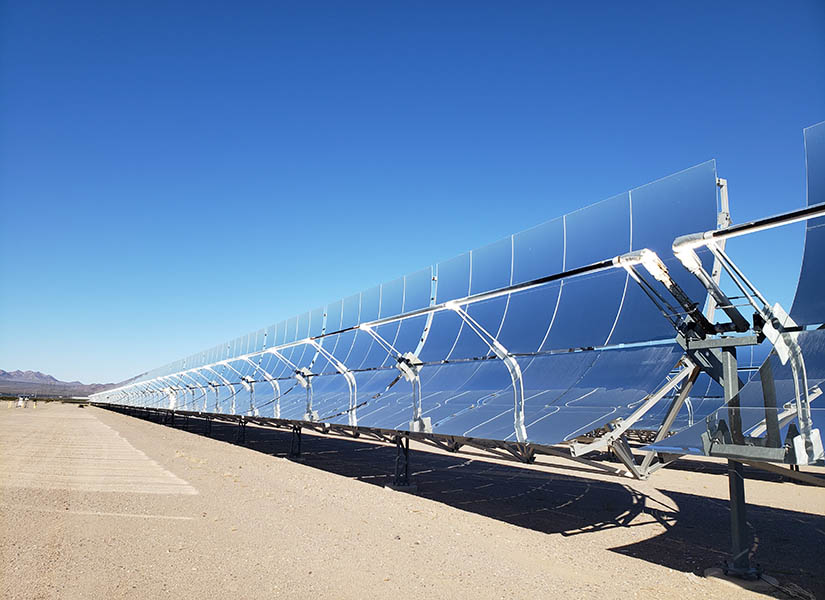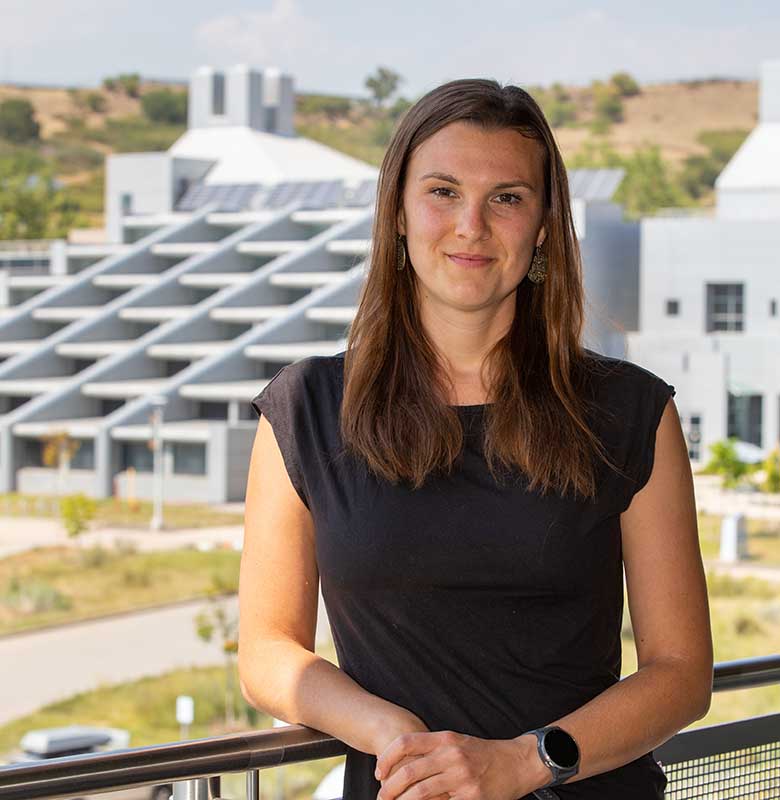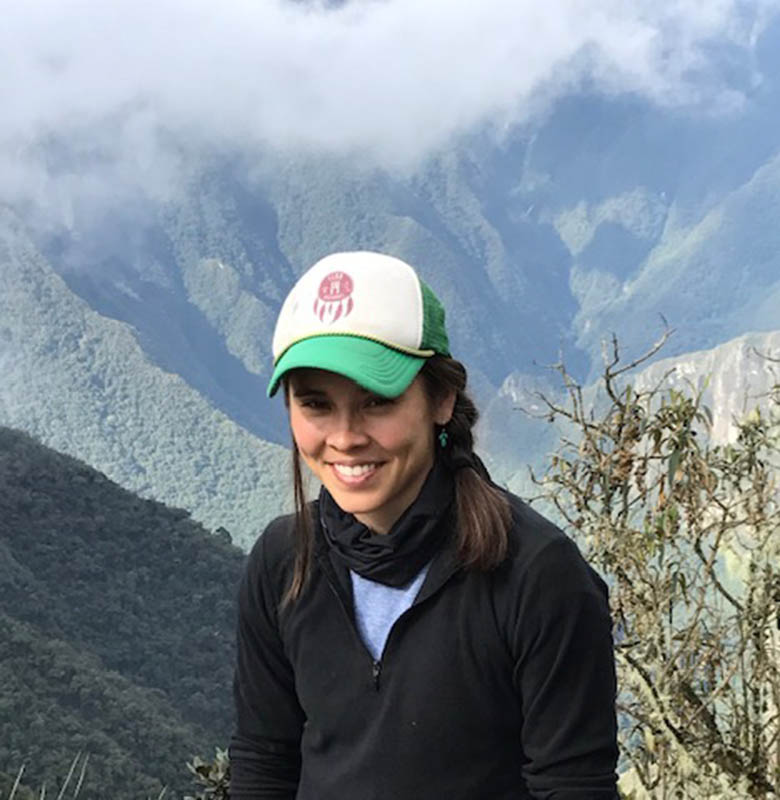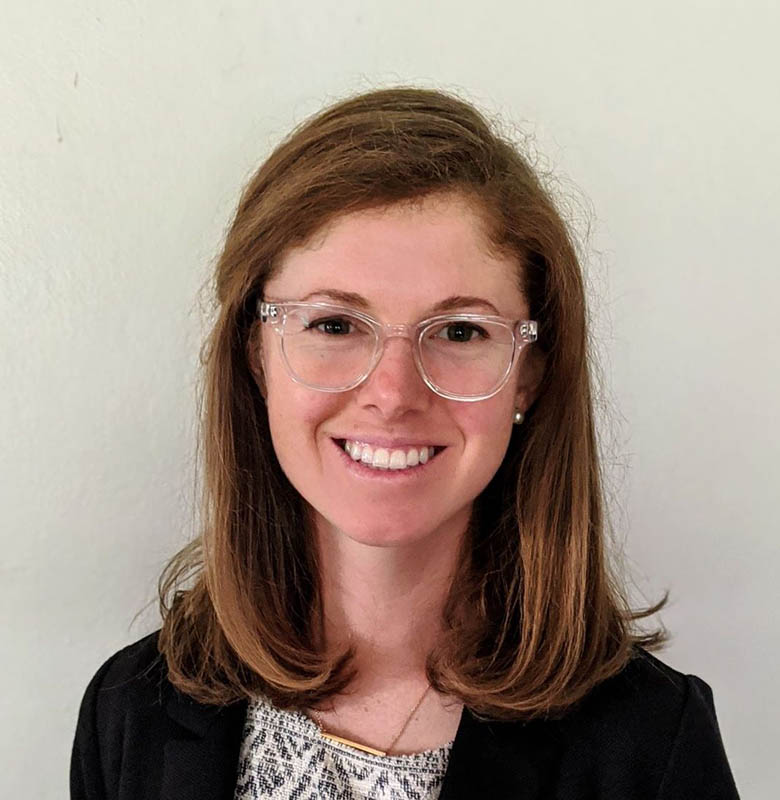Their Powers Combined: NREL Postdocs Study Turbulent Winds To Boost Concentrating Solar Efficiency
Most people have seen solar photovoltaic panels mounted on rooftops or lined up across sunny fields, but fewer people are as familiar with concentrating solar power (CSP). This form of solar power uses mirrors to concentrate sunlight onto a receiver filled with fluid. The sunlight heats the fluid, producing energy, which can be used to generate electricity. CSP technology can efficiently and inexpensively store some of that thermal energy, too, which means it can provide power even when the sun is not shining.
It makes sense to build CSP facilities in areas with abundant solar resources, like the American Southwest. However, these environments can also face turbulent, high-speed winds that put a lot of stress on the CSP facility’s mirrors and support structures—which can decrease efficiency and increase design and maintenance costs.
That is where three National Renewable Energy Laboratory (NREL) postdoctoral researchers (or postdocs, for short) come in. As part of a two-year project supporting NREL’s CSP program, these postdocs are working hard to understand the impact of turbulent wind conditions on parabolic troughs—a type of CSP collector that uses a tube positioned along a curved, mirrored structure to collect sunlight.
Working alongside established NREL researchers, the postdocs collect, assess, and model field measurements of wind conditions at the Nevada Solar One facility. Their findings will help the CSP community predict the impact of these conditions on CSP structures and performance and develop solutions for more resilient CSP facilities.
Curved, mirrored devices called parabolic troughs reflect sunlight onto receiver tubes
at the Nevada Solar One Facility. The thermal energy generated can be stored to provide
solar power even when the sun is not shining. Photo by Ulrike Egerer, NREL
We sat down with these three postdocs to discuss the paths that led them to their current roles, find out what lessons they have learned from their time at NREL, learn about their passions beyond the lab, and get a glimpse of their visions for a greener future.
Ulrike Egerer

Ulrike Egerer’s passion for flight evolved into a career dedicated to fighting climate change; now, she studies turbulent wind conditions at NREL to improve solar power efficiency. Photo by Werner Slocum, NREL
You might say Ulrike Egerer’s head has always been in the clouds, but this NREL postdoc’s focus is grounded in protecting the planet we call home.
When she was younger and still living in her native country of Germany, Egerer flew sailplanes in her free time and dreamed of becoming a professional pilot. As an adult, she earned her Diplom—a combination of a bachelor’s and a master’s degree—in aerospace engineering at the Dresden University of Technology. Diplom in hand, Egerer began her career as a mechanical engineer in the private sector. Then, she had her first child and went on maternity leave.
“That time off with my baby allowed me to ask myself what I wanted to do with my life,” Egerer said. “I started reading about renewable energy as a solution to climate change, and I decided I want to work in one of those fields—climate science or renewable energy.”
That decision led Egerer to start a Ph.D. in atmospheric science at Leipzig University, which took her on a research expedition to the Arctic. There, she led a campaign collecting wind turbulence data to feed climate change models. Her first postdoc role was at the University of Colorado Boulder (also called CU Boulder). This experience prepared her for the next stage of her professional journey, as a postdoc at the Department of Energy's NREL.
To support the CSP project, Egerer analyzes wind measurements at the Nevada Solar One plant.
“I study how the incoming wind changes as it passes over the solar collector rows and how the different wind conditions affect the collector structures at different locations,” she said.
Nine months into her postdoc, Egerer has found that she loves the supportive, collegial environment at NREL, as well as the mission to create a healthier, greener future for our planet.
“I think because we are all passionate about fighting climate change, everyone I work with is willing to help,” Egerer said. “Not only that—I get to bike to work two to three days a week. Quite a few of my colleagues do too. When the weather isn’t good for biking, we often carpool.”
Outside of NREL, Egerer still finds ways to spend time in the clouds. In addition to the usual outdoorsy Colorado hobbies, like hiking and rock climbing, Egerer and her husband recently started paragliding.
“Paragliding is great because it combines flying—my first passion—with hiking up a mountain and just being outdoors,” Egerer said. “It’s also easier to manage with kids. I have three now, and we try to take them outside as much as possible.”
Egerer has enjoyed working on the CSP project and wants to stay at NREL for a few more years. Then, she will decide where and how to further stretch her wings.
“I’m not exactly sure where my career will take me,” she said, “but I know that the experience I’m getting at NREL will help me no matter where I go next.”
Stephanie Redfern

After an already impressive academic career that culminated with her work as an NREL postdoc, Stephanie Redfern is preparing for an ambitious professional pivot: This summer, she will start medical school and study to become a physician. Photo from Stephanie Redfern, NREL
While working on a Ph.D. in atmospheric science at CU Boulder, Stephanie Redfern became familiar with NREL through her advisor, Julie Lundquist, who holds a joint appointment with CU Boulder and NREL. When Redfern saw an open postdoc position that called for someone with experience in wind resource assessment, she knew she had to apply. Redfern landed the job and now uses her wind modeling skills to support the CSP program as a postdoc in power engineering.
“I take the observed wind data that Ulrike collects, and I compare it against our weather model’s output to see how well the model is measuring and forecasting the winds within and around the solar plant,” Redfern said. “The hope is to develop a high-resolution wind resource data set akin to NREL’s Wind Integration National Dataset Toolkit for our study regions.”
Redfern’s work at NREL is the culmination of an impressive academic career that started with a bachelor’s degree in mechanical engineering and a master’s degree in global policy studies, both from the University of Texas at Austin, followed by a master’s degree in civil and environmental engineering from Stanford University, then added on that Ph.D. from CU Boulder.
“My interest in renewable energy really came into focus when I developed a better understanding of climate change through an undergraduate engineering communication class,” Redfern said. “When I went back to school a couple of years later to study policy, my focus was on climate change and learning how renewable energy could help.”
Similar to her postdoc colleagues, Redfern has found a culture of support at NREL that feels unique.
“Everyone at NREL is friendly, relaxed and open, so it's easy to talk to people about anything from technical issues to just personal life,” she said. “I don't think I have worked in a place before that had this openness and community feel.”
When she is not comparing wind data to wind model outputs, Redfern likes to read, run, play sand volleyball, and hike. She also used to play ultimate Frisbee.
Now living back in her hometown of Austin with her partner and family, Redfern is preparing to add to her already impressive degree collection—and to execute an ambitious career pivot. This summer, she will conclude her two-and-a-half-year chapter at NREL to start medical school at Pennsylvania State University, where she will study to become a physician.
“Climate change and renewable energy are still two things I care deeply about,” Redfern said, “but when I saw the impact the coronavirus pandemic had, I thought, ‘This is where I really want to make a difference.’”
Still, Redfern will take many valuable lessons from her time at NREL into the next chapter of her career.
“As a postdoc, I learned how to manage my time well, speak to a wide variety of people about different topics, tailor the conversation to fit their backgrounds, and how to do research,” she said. “Those skills will help me during my time in medical school and my future career as a physician.”
Brooke Stanislawski

Brooke Stanislawski uses computer modeling to evaluate CSP plant performance, all while protecting the planet and advancing her career at NREL. Photo from Brooke Stanislawski, NREL
Like her postdoc colleague Stephanie Redfern, Brooke Stanislawski is also an ultimate Frisbee enthusiast. In fact, it is possible that their teams squared off before Stanislawski and Redfern became colleagues.
“There may have been tournaments where our teams played against each other,” Stanislawski said. “We don’t remember each other’s faces, but we definitely overlapped in time and space.”
Stanislawski grew up in southern California and got her bachelor’s degree in mechanical engineering from Northwestern University, which is where she first discovered her interest in renewable energy.
“From a young age, I've always loved being outside, which I think predisposed me to being a fan of renewable energy,” she said. “I wanted to protect our outdoor spaces from the effects of climate change, and renewable energy is one way to do that. Then, as an undergrad, I joined a student group called Engineers for a Sustainable World, in which we designed and built a prototype wind turbine. After that experience, I knew I wanted to work in renewable energy.”
Stanislawski had been drawn to NREL since she first learned about the laboratory as an undergrad.
“I thought NREL was the coolest place because you could get paid to do research in renewable energy,” she said. “But at that point, I just thought, ‘That might be a cool place to end up,’ and pocketed the idea.”
After college, Stanislawski got a job designing wind and gas turbines for Siemens Energy but wanted to focus more on renewable energy. She started graduate school at the University of Utah, where she earned a master’s degree and a Ph.D. in mechanical engineering with a focus on fluid mechanics and solar energy. Then, as she neared the end of her Ph.D. program, Stanislawski saw a post on LinkedIn about a postdoc position at NREL.
“Like Stephanie, when I saw that job opening, I noticed that the job responsibilities were already very close to the work I had been doing,” she said. “My Ph.D. dissertation focused on numerical modeling of solar farms, and NREL was looking for someone to study the interaction between wind and solar farms and atmospheric flow, so I was excited to apply.”
For a year and two months as a postdoc at the laboratory, Stanislawski has supported the CSP project by using computer modeling to evaluate how the orientation of solar collectors impacts the performance of CSP plants. When she began the job, she found she could translate much of her technical expertise from her Ph.D., but she had to learn a lot as a newcomer to the fields of wind energy and CSP. Now, Stanislawski knows so much more—thanks, in part, to NREL’s supportive network of experts.
“When I first started, I was new to wind energy—aside from my short stints in undergrad and industry—and hadn’t had much experience being an independent researcher,” she said. “But I’ve enjoyed the freedom to chart my own course as I investigate research questions and identify which research questions are important. I’ve learned so much from my colleagues and mentors, and now I’m writing one of my first proposals. It’s so cool that we have all this knowledge at the lab that we can tap into.”
Based in Salt Lake City, Utah, Stanislawski enjoys bringing her 1.5-year-old daughter along on hiking, backpacking, and, hopefully, future snowboarding excursions with her partner. She still plays competitive ultimate Frisbee, and, like Redfern, she recently took up sand volleyball—though their paths have not crossed in that arena.
“I started playing it over the pandemic, and I love it,” she said. “I want it to be my retirement sport.”
Stanislawski is still considering the next steps in her career, but she knows she wants to remain in the field of renewable energy.
“I don’t know what specific position I want to end up in, but I do know that I want to keep improving energy from this technical perspective of fluid mechanics and simulations. And NREL has endless opportunities to keep learning, so it’s a great fit for my career goals.”
Want to advance your renewable energy research career? Visit NREL’s postdoc opportunities page. Interested in helping move CSP technologies into the U.S. marketplace? Find out how you can work with us. And sign up for NREL’s wind energy and solar power newsletters to stay current on wind energy and solar power news.
